The Cotswolds are noted for their idyllic villages with honey-coloured buildings, thatched roofs, epic scenery, history and culture. Looking as if you have stepped into a timewarp, the gorgeous village of Lacock stands out as one of, if not the most beautiful village in the Cotswolds.
For a small Cotswolds village with only four streets, Lacock has a surprising number of things to do and see. In fact, I have to admit, on my first visit to the village I thought I would have a look around the Abbey and maybe a quick wander in the village, take some photos and that was me.
*This site uses affiliate links and I may earn a small commission when you use my links and make a purchase without incurring an additional fee yourself.
Thank you for supporting this website. See my disclaimer page for more details.
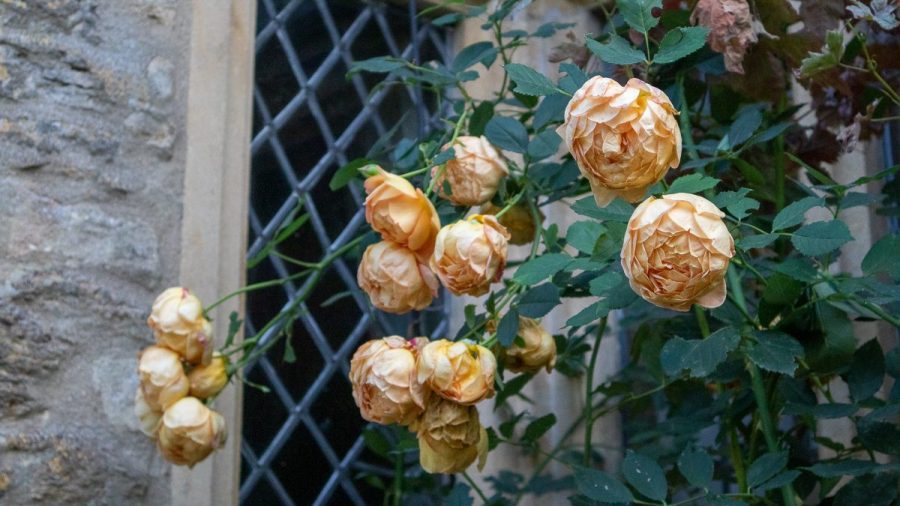
How wrong I was. There is so much more to do in the village. Things to see, independent shops to visit, walks, tea shops, restaurants, the magnificent Abbey, the birthplace of photography and heaps more.
There is also a lovely vibe about the place. People smile, take time to chat and are very helpful even though there was a deluge of visitors and tourists. It is the perfect place to spend a morning, afternoon or whole day wandering around soaking in the atmosphere..
A bit of background to Lacock
Pre Middle Ages
Lacock is in the south of the Cotswolds near Bath and Chippenham. There has been a settlement in the area since Saxon times when people lived along the banks of the Bide Brook and the church. The settlement was called ‘lacuc’ or ‘little stream’.
First mentioned in the 1086 Domesday book, it was then a small village of less than 200 with two mills and a vineyard.
The village was really put on the map when the abbey was founded by the influential Ela, Countess of Salisbury. A formidable lady, she succeeded to her title in 1196 at the age of 9 on the death of her father William FitzPatrick.
Also in that year, she married William Longespée, who was about 13 years older than her. It is assumed that the marriage was not actually consummated until she was at least 14 or 15! Before you recoil in shock, times were different back then and what we would now see as underage marriages were commonplace.
In 1232, after the death of her husband, Ela founded Lacock Abbey as an Augustinian nunnery. In 1238 she entered the order herself as a nun and in 1240 became abbess.

The Middle Ages
Like many abbeys, convents and monasteries in the 16th Century, the Abbey was dissolved under King Henry VIII when he split from the Catholic Church in Rome. Finally, in 1539, Lacock Abbey was shut down after 300 years of religious use.
The following year it was bought by William Sharington who converted the abbey into a country house. In the process, both the church and the lady chapel were destroyed, though the cloisters were kept. He also added the octagonal tower.
Surviving buildings from this time include the 14th Century Tithe Barn and St Cyriac’s Church and the 15th Century Sign of the Angel inn.
18th and 19th Centuries
In the 1800s the village was laid out in a grid of four streets. Yes, essentially, Lacock is still made up of only four main streets: High Street, East Street, West Street and Church Street.
Most of the buildings in the village that you see today, come from that the 18th Century when Lacock’s main income was from wool. Sadly, like many of the surrounding towns and villages, the wool trade dwindled in the nineteenth century.
The Abbey was passed down to the Talbot Family who extended the upstairs and turned it into a manor. Luckily the cloisters and many of the abbey rooms were left untouched.
The most famous member of the Talbot Family, William Henry Fox Talbot, was born in 1800, more on him later.
20th Century
The estate was passed down through the Talbot, and latterly Fox Talbot families until in 1916 it was passed to Matilda Gilchrist-Clark who adopted the name, Matilda Talbot.
Lacock and the National Trust

In 1944, the whole estate, including the Abbey, village and around 284 acres, was given to The National Trust by Matilda Talbot.
The National Trust still owns most of Lacock and around 1,000 people live in the village with many of the houses rented from the Trust.
As it is kept as a National Trust tourist attraction, Lacock looks very much like it did 200 hundred years ago and you can imagine dashing gentlemen and ladies in crinolines strolling about the streets and horses and carts carrying goods to market.
10 Best Things to do in Lacock
If you don’t have time to read the whole post, here are the highlights!
The best things to do in Lacock village
Now you know a bit of the background to the village, let’s look at the best things to do when you spend some time in Lacock.
Visit Lacock Abbey
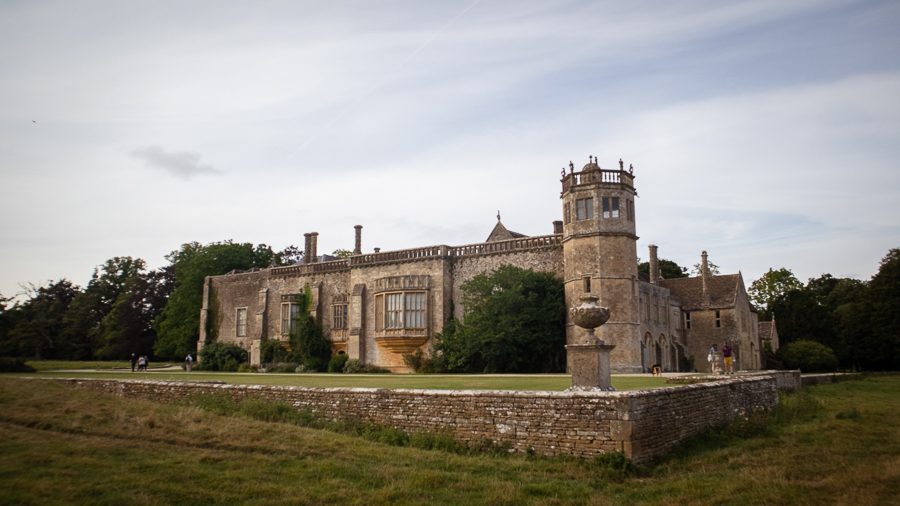
One of the biggest attractions is a visit to Lacock Abbey. The stunning example of 13th Century architecture built from warm golden-coloured Cotswold stone and is set in beautiful grounds.
The many later additions, as mentioned above, changed the shape and dynamic of the Abbey into a manor house, but it remains a fascinating place to visit. There is the octagonal tower and the dramatic bay window which were added in the 18th Century.
Any ‘Potterhead’ will love visiting the cloisters and abbey rooms which doubled as Hogwarts School’s cloisters in many of the Harry Potter films..
The grounds are also extensive and are pleasant to walk around, though if you have a dog with you they will have to be on a lead as cattle and sheep still graze there. Parts of the grounds are available to walk around without actually paying to enter the abbey itself.
Address: Ticket Office, the bottom of The High Street, Lacock, SN15 2LG
Price: from Adults £15, Children £7.50 (includes Fox Talbot Museum)
Hours: 10:00 – 16:45 – Abbey Cloisters; 10:00 – 17:00 – Abbey Grounds – 7 days a week
Fox Talbot Museum

It is hard to imagine that this small village is actually the birthplace of photography.
Born in 1800, William Henry Fox Talbot lived with his family in Lacock Abbey. In August 1835 he managed to capture the world’s first photographic negative of a window in the Abbey. This small image changed the way we see capture the world and print it on paper.
The Fox Talbot Museum takes you through where Fox Talbot fits into the history of photography. It gives an insight into what inspired his invention process and the making of the first negative.
Upstairs in the museum is a changing photography gallery. For details of the current exhibition see the National Trust website.
The museum is in the same building as the Ticket Office for the Abbey and there is a joint ticket for both.
Address: Ticket Office, the bottom of The High Street, Lacock, SN15 2LG
Price: from Adults £15, Children £7.50 (includes Lacock Abbey)
Hours: 10:00 – 17:00 – 7 days a week (may have seasonal timings)
Tithe Barn and Blind House

On the corner of High Street and East Street is the 14th Century Tithe Barn. The tithe barn was connected to the Abbey when it was used to hold tithes. These were the contribution from produce, fleeces, crops etc that the villagers paid to the abbey in lieu of rent.
The barn is vast and has stunning cruck-framed roof which arches over the limestone walls. Formed in a T-shape it is an amazing example of the complex joists used to support the roof.
The tithe ban has been restored over the years, but remains as it was in medieval times even with a beaten earth floor.
The barn has had a few other uses over the years including a market hall, grain store and threshing area, exhibition space and a film location.

Next to the stunning Tithe Barn is the Blind House. A stone building without windows was the lock-up for the drunk and disorderly in the 18th Century. People were placed in there to sober up before coming before the judge in the morning.
As they couldn’t see outside, the buildings were named Blind Houses. There are many of these across Wiltshire including Malmesbury, Bradford upon Avon, Great Bedwyn and Chippenham.
St Cyriac’s Church
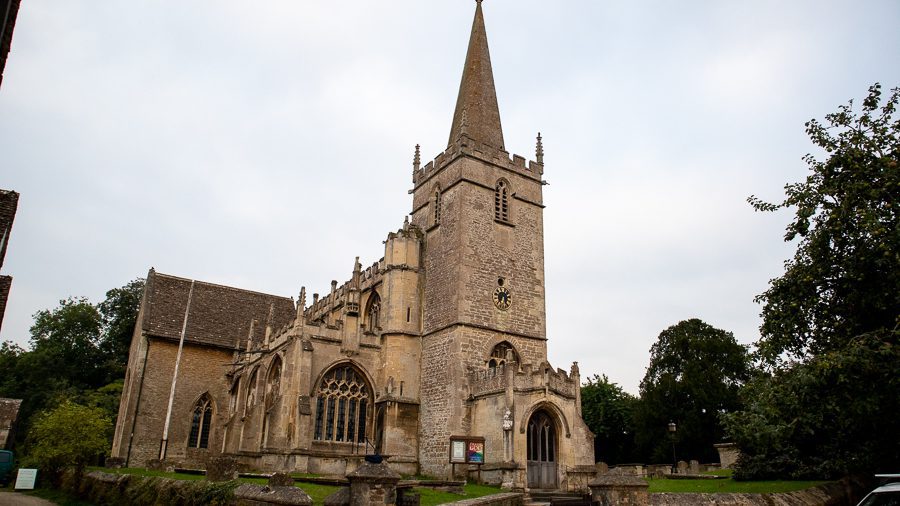
The Grade I listed St Cyriac’s Church is another example of 14th Century architecture in the village. Its basic design is Norman and it was dedicated to the Normal saint St Cyriac.
The base of the current church was built in the 11th and 12th Centuries but was rebuilt in the 14th Century with later additions in the 1600s and 1800s.
Be Tempted in the Shops
You might be quite surprised about the number of independent shops there are in the village.

At the top of church street and just around the corner are the beautiful buildings of the former Lacock Workhouse. Downstairs is the studio of John Watling. He makes stunning bespoke silver and gold jewellery with gemstones including a gorgeous multi-faceted pendant with different gemstones that I secretly covet!

Stop off at Wiltshire Crafts in Church Street for a range of hand-made jewellery, cards, homewares, woodturning and ironwork, and, of course, Harry Potter goodies.

Further down West Street is the divine Quintessentially English full of beautifully scented organic soaps, lotions and bath bombs.

Head up to West Street and just to the right of the cute bus stop are the signs into the courtyard and my favourite The Chocolate Barn – also known as CoCo Chemistry – for the best artisan chocolates ever!
Also in the courtyard are Barty’s Eco Shop or browse the antiques in Sue Stokes Antiques and Emporium.
After perusing the antiques in West Street, turn left down the High Street, don’t miss the Lacock Post office and Food Store with its fabulous delicatessen. There is a delightful range of quiches, salads, vegan cakes and more.

Across the road from The Food Store is the National Trust Shop, the perfect place. to pick up some souvenirs from your trip to Lacock, maybe a book on photography, or a plant or two.

Pop some money in an honesty box

Strolling around the village you will come across little stalls outside people’s houses with honesty boxes or notices to pop money through the letterbox. Look out for plants, crockery, jams, hand-made items and books along the way. Help support the villagers by having a look and maybe buying something.
Riverside Walks

There is a 2 miles circular walk around the village.
Starting off at the top of Church Street, there is a path opposite St Cyriac’s Church leading to the Ford.
Cross the bridge and walk up Lover’s Lane, at the top turn right and go through the gate. The path leads you across the field. There may be cows in the field, so keep dogs on a lead.
At the other side of the field, pass through another gate and down the lane until you get to another bridge and just after it on the right-hand side is a sign showing the way across the field.
Keeping the river to your right, stroll through the fields and across the bridges back to the village.
Pop into the Ticket Office for a handout of the walk.
Discover Filming Locations around Lacock
Lacock is the idyllic setting for many films and tv programmes. It retains the charm of an 18th Century village with half-timbered buildings, honey-coloured buildings, a wide high street and narrow streets and a fabulous quirkiness.
Harry Potter

Lacock has featured in several Harry Potter movies about the most famous of young wizards, Harry Potter. In fact, The Philosophers Stone, The Chamber of Secrets, Harry Potter and the Half-Blood Prince, and, Fantastic Beasts: The Crimes of Grindelwald have used Lacock as a backdrop.
The cloisters of the abbey have doubled as Hogwarts corridors in several of the early movies and the cloister rooms have been transported into Professor Snape and Professor Quirrel’s Classrooms.
Next to St Cyriac’s Church is a beautiful cottage with a green door. This private house appears in a scene from The Philosopher’s Stone as Harry’s parents’ house. Hagrid tells Harry what happened to his parents when he was a baby. In a flashback, we see Voldemort enter the house and kill Harry’s parents with magic, leaving Harry behind.
Like Harry’s parent’s house, 4-6 Chapel Hill is also a private residence but featured in the Harry Potter and the Half-Blood Prince. Horace Slughorn hides out in this house from the Death Eaters.

The Beautiful 15th Century Sign of the Angel doubles as the Babberton Arms in Harry Potter and the Half-Blood Prince.
Downton Abbey

The High Street was transformed for a royal parade in 2019. It is wide and allowed for the crowds to line the street to watch the parade go by. In 2015, Church Street became a market complete with pens of sheep and cows. Carson’s cottage was also filmed in Lacock.
Other programmes and films that have been filmed in Lacock
Some of the other programmes and films that have used the village as a location include:
- Hollow Crown (2012 & 2014)
- The White Princess (2006)
- Moll Flanders (1996)
- Pride and Prejudice (BBC TV series 1995)
- Cranford (BBC TV series 2007-2010)
- The Other Boleyn Girl (2008 film)
- Galavant (ABC TV series 2015-2016)
- Dr Thorne (ITV series 2016)
- His Dark Materials (BBC series 2019)
- The Wolfman (2010)
- Wolf Hall (2014)
The Highlights of the Four Streets in Lacock
High Street

- visit the National Trust Shop
- pop into the Village Shop
- have lunch, dinner or a drink in the Red Lion
- enjoy a coffee in The Stables Cafe
- learn about photography at the Fox Talbot Museum
- visit Lacock Abbey
East Street
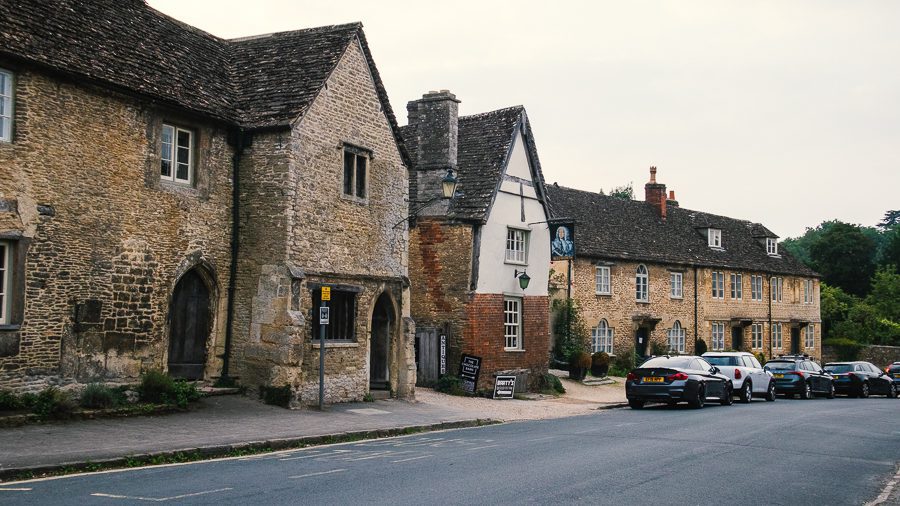
- Pop into the George Inn for a drink
- Indulge in some handmade chocolates at The Chocolate Barn
- Look for antiques in Sue Stokes Decorative Antiques
- Pop in to Barty’s Eco Shop
- Fall in love with the scents in Quintessentially English
Church Street

- Take a drink, meal or even stay at The Sign of the Angel
- Have tea in Lacock Bakery or buy some fresh bread
- Admire St Cyriac Church
- Enjoyafternoon tea in King John’s Hunting Lodge
- Visit John Watling‘s bespoke jewellery studio
- Check out Wiltshire Crafts for handmade items
- Take a walk past the ford and up Lover’s Lane
West Street

- Be awed by the 14th Century Tithe Barn
- Imagine being locked up in the Blind House
- Indulge in some of Watlings Jewellery
Best Places to eat in Lacock
Sign of the Angel

Apart from looking gorgeous from the outside, the 15th Century Sign of the Angel is delightful inside too. With large open fireplaces to warm yourself, simple decor that enhances the age of the building, it is a pleasure to visit.
The menu caters for vegetarians as well as meat eaters and uses local produce to keep their carbon footprint low and to support the artisans and suppliers. The menu includes contemporary dishes like delicious salads, tarts, fish as well as classic lamb and pork.

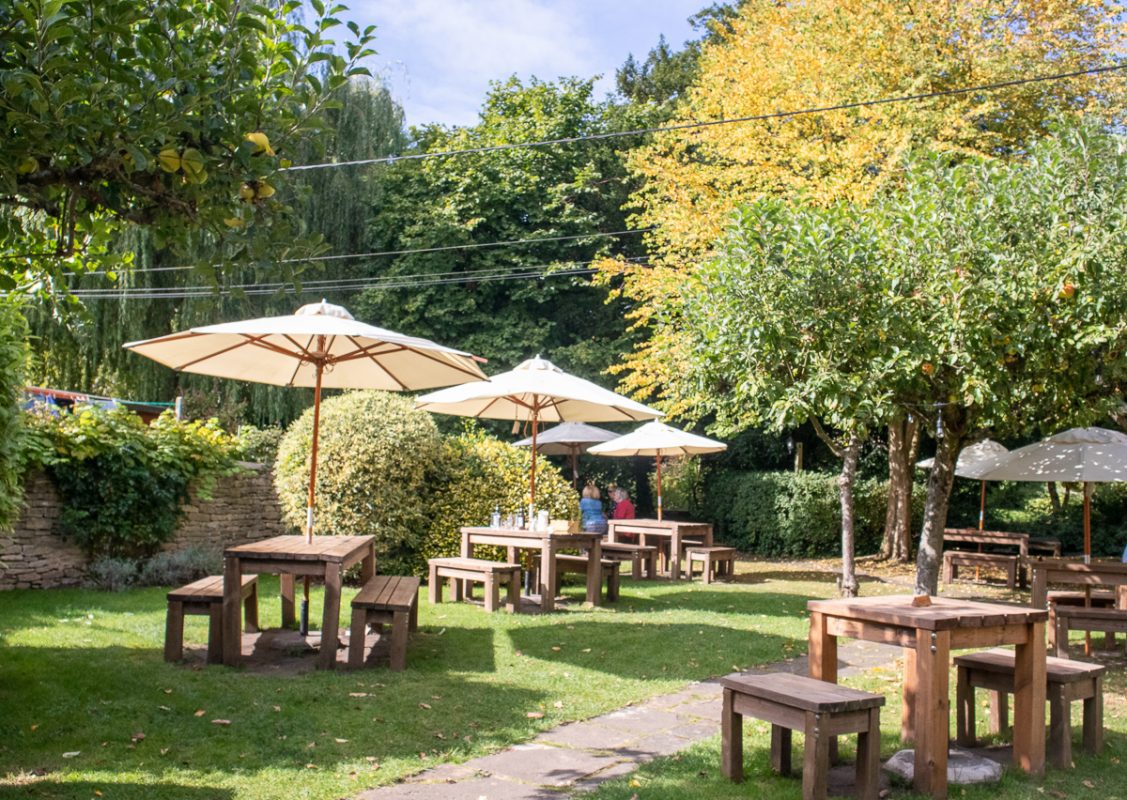
When the weather is not good, warm yourself up by one of the huge fireplaces in the dining areas. When the sun shines head outdoors to eat at the tables and benches in the garden. Sit in the shade of the umbrellas or apple tree and admire the view and the food!
Address: Sign of the Angel, Church St, Lacock, Wiltshire SN15 2LB
The Red Lion

The Red Lion at the bottom of the High Street. Pop in for a drink or a meal. The menu is modern British pub food with choices for vegans and vegetarians.
If the weather is warm, sit outside under the tented area. Don’t worry, there are heat lamps if there is a chill in the air.
Address: The Red Lion, 1 High St, Lacock, Wiltshire SN15 2LQ
Lacock Bakery

You will be greeted by wafts of freshly baked bread as you come close to the Lacock Bakery and there may also be a queue. One of the most popular shops in the village, the bakery sells different breads including a five-seeded cottage loaf or their cob with sun-dried tomatoes.
They don’t just sell bread, but carrot cakes, chocolate cookies, pasties, and cute sugar mice.
You can enjoy a cup of tea while sitting around the farmhouse table or take your goodies away to enjoy later.
Address: 8 Church Street, Lacock, Wiltshire, SN15 2LB
King Johns Hunting Lodge
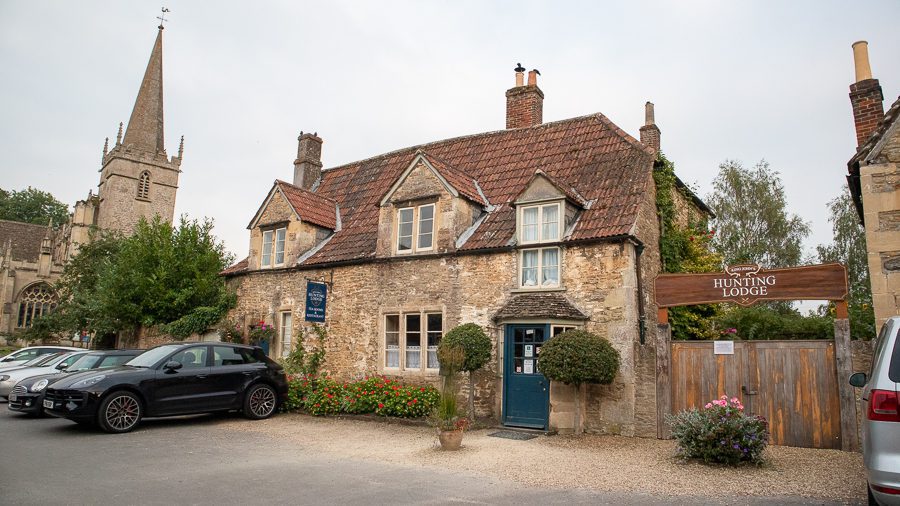
The King John’s Hunting Lodge in Church Street is so pretty with a lovely walled garden where you can take Afternoon Tea or sit in the restaurant for traditional English fare with an all-day breakfast, lunches and sandwiches.
Address: 21 Church Street, Lacock, Wiltshire, SN15 2LB
(Note: King John’s Hunting Lodge is closed until 2022)
The George Inn
Serving classic pub food including fish and chips, ham, egg and chips or sausage and mash, The George Inn also has burgers, pies, chicken wings and a selection of vegan and vegetarian dishes.
Address: 4 West Street, Lacock, Wiltshire, SN15 2LH
Best Places to stay in Lacock
If you want to extend your stay in the Cotswolds, why not base yourself in Lacock. Its tranquil surroundings are perfect for a longer visit.

Talbot House
Just a short walk from the centre of Lacock, Talbot House is a delightful, inviting period cottage with views over the village.
The room is light and airy with a comfortable double bed and en-suite shower. You have your own sitting room to chill out in and there is a microwave if you want to make some food to eat in the garden or sitting room.
With off-road parking, it is the perfect place to relax.
Address: 7 Cantax Hill Lacock, SN15 2JZ
Book your stay at Talbot House
The Nest at Bramble Cottage
The Nest at Bramble Cottage is a sweet home-from-home with a bedroom/living room. The bathroom has a shower. There is a kitchen with a microwave, dishwasher and everything you need if you are self-catering. Sit out on the terrace or garden. Inside there is a flat-screen TV and free WiFi.
Address: The Nest at Bramble Cottage, 47 Notton Park, Lacock, SN15 2NG,
Book The Nest at Bramble Cottage
Barn Cottages
Barn Cottages has three beautifully designed self-catering holiday cottages to choose from – Chestnut, Maple and Cherry. Each one sleeps four, with a double and two single beds. There is an open-plan kitchen/dining room and comfy sofas to relax on.
Outside you can enjoy the sun on the patio area or have a barbecue.
Address: The Barn Notton Park, Lacock, SN15 2NG
Check the rates for Barn Cottages
Sign of the Angel
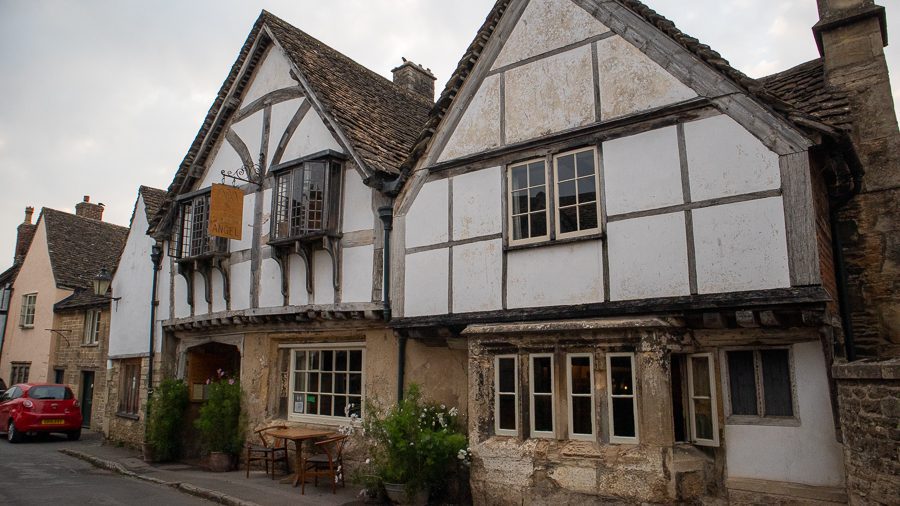
With five rooms above the restaurant, a stay in the Sign of the Angel is a delight. The 15th Century Inn has quirky features from low beams and rounded plastered walls.
The rooms are decorated in neutral colours and have cosy duck and down pillows and duvets to keep you warm. There are tea and coffee making facilities and some of the chef’s homemade treats to welcome you.
With ensuite bathrooms, it is the perfect place to stay in Lacock.
Address: Church St, Lacock, SN15 2LB
Enjoy at night at the Sign of the Angel
CHECK OUT OTHER HOTELS AND PLACES TO STAY IN LACOCK
How to get to Lacock
By Car
Driving to Lacock from the M4 is quite easy. Leave the M4 at Junction 17 and head south on the A350. After about 9 miles you will see the brown National Heritage signs directing you to Lacock.
Parking in Lacock
The streets in Lacock are quite narrow and there is residents only parking in most of the streets and lanes.
It is preferred that you park in the large National Heritage Car Park on Hither Way. The car park is well sign-posted so you shouldn’t miss it.
If you are a National Heritage member you can park for free, don’t forget your membership card as you will need it. If you are not a member, there is a charge of £4.50 for the day which you pay via an app or with coins.
By Public Transport
If you are visiting Lacock by public transport, the nearest train stations are Chippenham. If you are travelling from London, there is a direct train which takes around an hour and 20 minutes. From Chippenham, you can take the X34/First 234 bus to Lacock.
Why not join a tour which includes a visit to Lacock?
Choose one of the tours from Get Your Guide that to Stonehenge, Bath and Lacock.
Where to go next in the Cotswolds?
With so much to see in the Cotswolds, where should you go next? If you are staying in the south, try a day trip to picturesque Castle Combe, Melksham, Bradford upon Avon or see the peacocks wandering around Corsham.
Up to the north, you have the Slaughters, not gruesome, I promise, Malmesbury, Bibury with the 14th Century Arlington Row, Tetbury, Cirencester and many other delights.
Don’t miss out on a visit to Bath, Stonehenge or Avebury or maybe see some of the White Horses in Wiltshire.
Don’t forget to pin this article so you can come back to it later


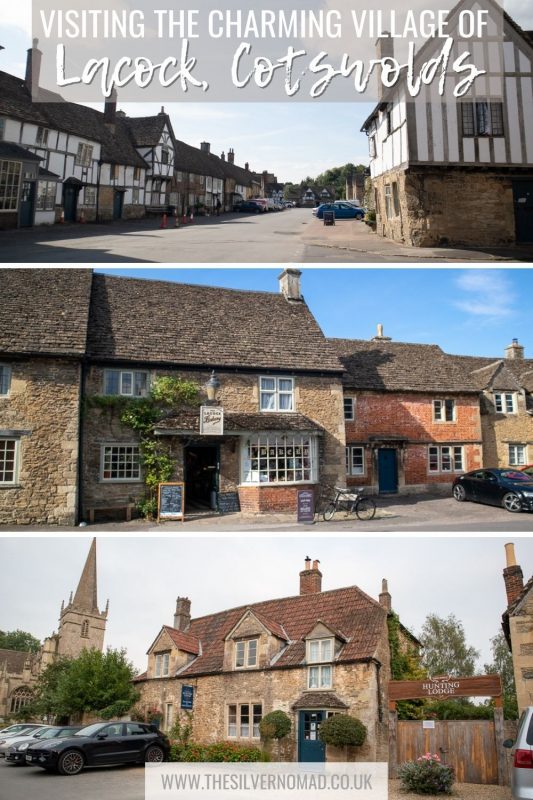

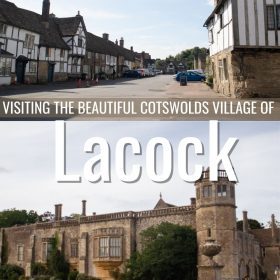

Pingback: Most Beautiful Places to Visit in England in Winter - Home Travel Guide
A small village like Lalock with only 4 streets sounds like a perfect place to escape. I too would be surprised to find so much to see and do. With so much history I am sure to learn a lot as we wandered the town and visited the museum. Fun that each street has something interesting to see.
It is a beautiful place to visit Linda, hope you add it ti your UK bucket list!
I’d plans to visit the Cotswolds but due to a change of plans I missed this area of England. I’ve not heard of Lacock but it looks like the most adorable village! I love that there are really only 4 streets to explore. I’d definitely want to visit the abbey as its gorgeous and I’m a fan of Harry Potter movies! I’d also like to visit the Talbot museum as I always love learning about the history of a place!
Lacock is definitely worth a visit Vanessa, hope you make it.
Great post! I love Lacock, and your post has made me want to visit again. I love walking through the old village and visiting Lacock Abbey, it’s like stepping back in time. Thanks for sharing!
It is such a beautiful place, I love it